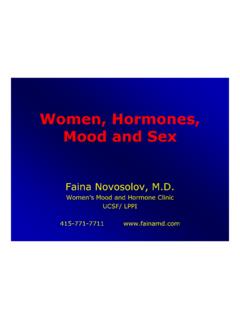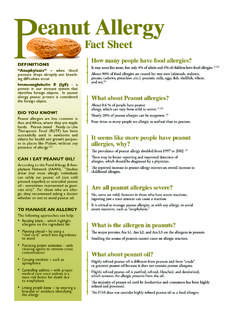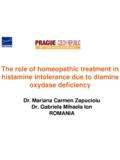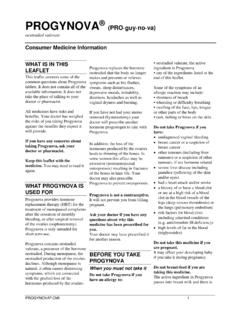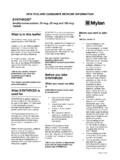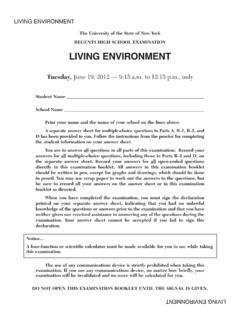Transcription of is Candida Albicans. Overgrowth of Candida results in the ...
1 Candida - Cause And Effect Candidiasis is the medical term used to describe a yeast Overgrowth that is usually found in the intestinal area and other tissues of the body. It has become a very serious problem within our society. Other terms for this condition are Candida Albicans or just Candida . It is by no means a new medical problem. In fact, it has been around for centuries. However, Candidiasis has become a chronic, modern-day medical dilemma that seems to be increasing rapidly. It is called the Missing Diagnosis . The constant struggle for dominance by various microorganisms inhabiting the human body, especially the struggle between yeast and the ben-eficial bacterium, can periodically upset the delicate internal balances and cause poor health.
2 Candida is truly a nega-tive yeast infestation that begins in the digestive system and can slowly spread to other areas of the body. It is a strong, invasive parasite that attaches itself to the intes-tinal wall and becomes a permanent resident of your internal organs. It is causing numerous health problems and discomfort for over 30 million women every day and it is estimated that nearly everyone has or will have a moderate to serious Candida condition at sometime in their lives. Yeast is an integral part of life. It is present in food, and is found on the exposed surfaces of all things, including the air that we breathe. Candida yeast intake and exposure cannot be avoided. Only when yeast becomes dominant in various parts of the body does it begin to present a serious health problem, resulting in disease and pain.
3 Yeast can become a hardy, aggressive fungus. It multiplies rapidly, can assume long periods of dormancy and, when neces-sary, becomes cannibalistic. There are approximately 250 species of yeast, many of which are parasitic to the human body. The major yeast specie present in humans, however, is Candida Albicans. Overgrowth of Candida results in the condition known as Candidiasis , which commonly produces localized symptoms by invading the tissues of the mouth, gastrointestinal tracts, vaginal area, urinary tract, prostate gland, skin, fingernails and toenails. Normally, a healthy immune system controls Candida levels. However, circum-stances may occur that can permit an excessive yeast over-growth, such as prolonged use of antibiotics, steroids, birth control pills and excessive sugar intake.
4 The resulting yeast toxins can damage or cripple the immune system, and not only make the body vulnerable to a primary yeast infection, but to secondary bacterial and viral invasions as well. These toxins weaken the body s immune response to all invad-ing antigens. An antigen is anything that is foreign, toxic or unnecessary to the health of the body s cells. If the immune system is strong, it can remove these antigens. In cases where the immune system is clearly impaired, high levels of yeast toxins can interfere with normal tolerances, resulting in exaggerated sensitivities to specific substances. This creates allergic reactions of varying intensities within the systems of the body. They can include reactions to certain foods, pol-lens, odors, chemicals, and products such as shampoos, cosmetics, perfumes, etc.
5 As yeasts enter the body through the mouth via the air, food or water, they are looking for a place to settle and grow. If they are not destroyed by the friendly bacteria or the immune system, they will attach themselves to the intestinal wall and begin growing and reproducing. As this happens, the yeast cells produce toxic substances and wastes. Seventy-nine known toxins have been isolated from yeasts and some researchers believe there are more than one hundred toxins so produced. The major waste product of yeast cell activ-ity is ACETALDEHYDE. Candida can multiply very quickly and after many years of growth, the buildup of acetaldehyde toxins can be overwhelming to the body tissues. The poison is transformed into ethanol and converted by the liver to alco-12hol. This depletes the body of magnesium and potassium which reduces cell energy.
6 These two minerals are absolute-ly essential for tissue strength and integrity. The less oxygen there is in the body, the more alcohol is produced which may produce symptoms of being drunk, disorientated, dizzy, or mentally confused. Even panic attacks, feelings of anxiety, depression, irritability and headaches are often the results of a Candida yeast Overgrowth within the body. Acetaldehyde can cause excessive fatigue, reduce strength, stamina, clar-ity of thought and discourage ambition. It destroys enzymes needed for cell energy and causes the release of free radicals which increases the aging process. When Candida enters the bloodstream it can travel quickly and will invade the tissues causing joint pain, chest pain, sinus and respiratory inflammation, glandular stress, menstrual problems, etc.
7 However, the most damaging result to the body is to the immune system. The Candida poison stresses and weakens the immune system constantly, 24 hours a day. The majority of immunological diseases and infectious conditions are caused or worsened by the pres-ence of Candida throughout the body. The white blood cell count rises when Candida yeasts and their numerous tox-ins are constantly being neutralized by the body s immune defenses. If this source of body pollution is always being generated, the immune system eventually becomes ineffec-tive, setting the stage for severe health problems. The majority of people who have Candida do not real-ize they have it until they become seriously ill. The symptoms are so numerous and seemingly unrelated that it is very per-plexing to both doctor and patient.
8 Often several debilitating complaints can accompany yeast infections, simultaneously. The symptomatology of Candidiasis is wide spread and var-ied. Many of the symptoms are not caused by the Candida directly, but run parallel to or in connection with it. One symp-tom may contribute to another, so Candida may not be the cause of all symptoms but may be indirectly weakening the absorptive process, damaging the immune response, interfer-ing with the production of hormones or impairing the nervous system. Candidiasis can damage the body in many ways and cause serious organ dysfunction. It is estimated that at least one-half of all North Americans suffer from Disrupts Many ActivitiesWithin The Body And ContributesHighly To A Host Of Physical &Mental Conditions And Diseases Candidiasis can present a wide variety of symptoms, the exact combination and severity of which depend upon the individual case.
9 By nature of their vast diversity, the symp-toms may appear unrelated. They are usually chronic and include, but are not limited to, the following:ALLERGIES Allergies to foods or airborne chemicals, especially if these are acquired in adulthood. In other words, a Candida condition may contribute significantly to your spring hay fever, swollen eyes and sneezing. The number of offending substances keeps increasing until many individuals become so sensitive to the everyday environment that they must live in isolation or move away to another climate. Absorption of incompletely digested proteins is a major cause of allergy conditions. The Candida weakens the digestive system, thereby not allowing the total breakdown of amino acids, causing food allergies.
10 This may produce a wide spectrum of severe allergic reactions. If proteins are not completely digested and broken down into free amino acids, they can be absorbed into the blood and will irritate the tissues. The immune system sees them as foreign or toxic invaders of the 43body and a powerful immune response is initiated. An imme-diate or slightly delayed chemical chain reaction of events then occurs causing an allergic reaction which is triggered by certain foods or airborne antigens. The combination of poor protein digestion and the presence of Candida toxins causes the immune system to become confused, resulting in the chemical or food sensitivities we call allergies. If there were no Candida toxins present in the body, protein digestion would be efficient and allergies would not be biochemically created.
